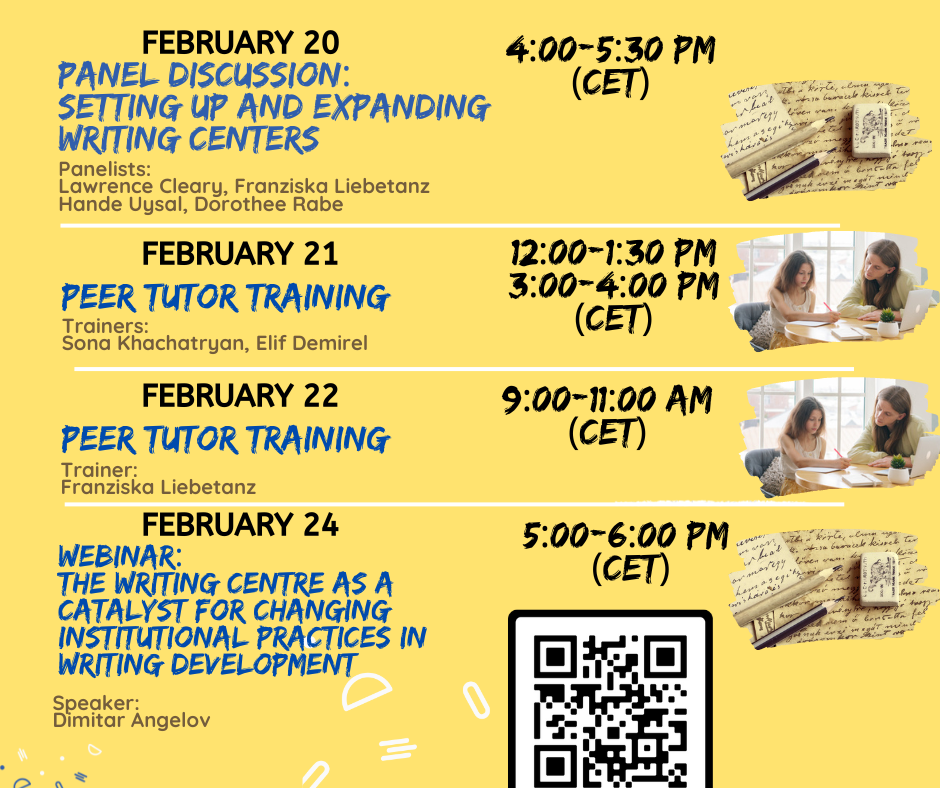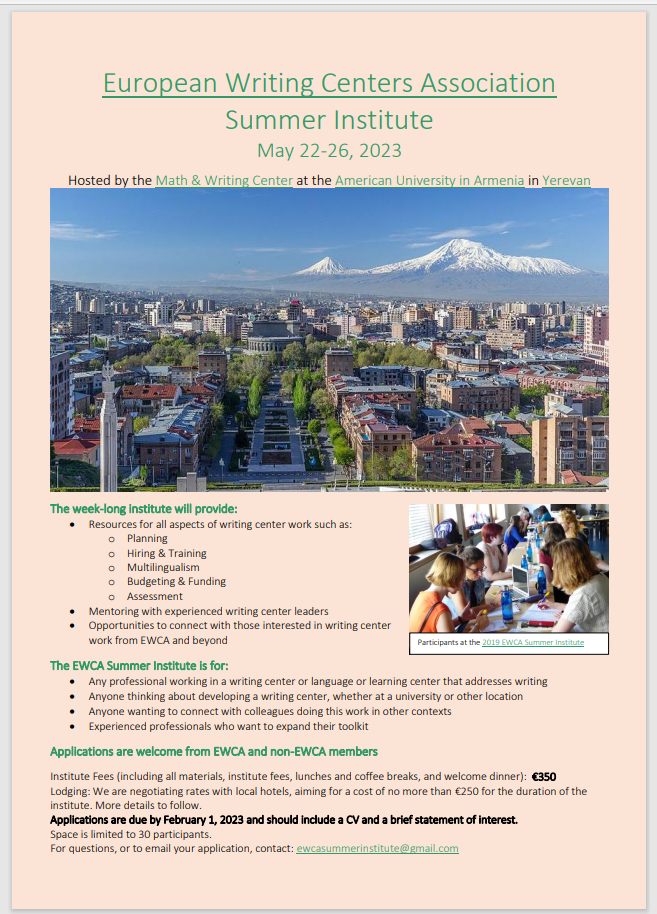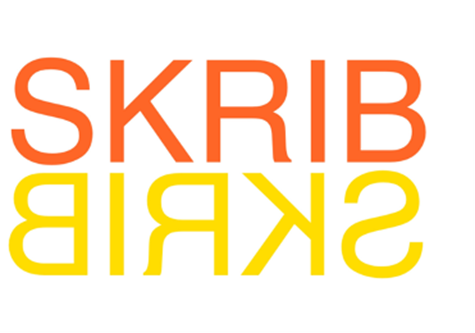EWCA 2025 summer Institute, jUNE 05-11
Presentations by Mostafa Nazari on Writing Social Science Research Papers
Mostafa Nazari is currently a PhD candidate at Kharazmi University in Tehran, Iran. He completed his Bachelor of Arts in TEFL in Mohaghegh, Ardebili University, Ardebil Iran in 2014. He then received his Masters of Arts, in 2016, from Kharazmi University, Tehran with his thesis titled “The correspondence between Iranian EFL teachers’ dispositions toward task-based language teaching and their TBLT-related instructional practices”. Currently he’s working towards his PH. D. in Applied Linguistics in Kharazmi University. His dissertation title is “Conceptualizing the role of emotions in young English learner teachers’ identity construction: A case study from Iran”. And his research interests are teacher, education and professional development, teacher identity, teacher emotion, teacher cognition, technology and teacher education, action research and language assessment.
Mostafa had delivered three workshops designed to provide a forum for researchers to become more familiar with the structure and content of research articles, specifically, articles of between 6000 to 8000 words that report on the findings of original studies and make empirical contributions to the field of knowledge.
Recorded are three 2-hour sessions, the first delivered on June 16th, 2023 on introductions and literature reviews, the second, on June 17th, 2023, on methodology and outcomes and on June 18th, 2023, Mostafa presents on the discussion and concluding sections of these articles as well as on writing abstracts. The third session is split for some unknown technical reason and are listed as 3 a and 3 b.
The workshops are targeting researchers working on articles for publication as well as university instructors who wish to educate their students and preparing them for submissions to journals in their fields. The workshops are designed to help students hone their professional skills by learning how to structure their research articles on the way to meeting publication standards. Also, freelance researchers might benefit from these workshops, developing their competencies in academic writing.
Find the recordings below:
Mostafa Nazari _Writing Social Science Research Papers: https://media.heanet.ie/page/464fd3c6ed9842ffa550ec61a9d40ac8
Mostafa Nazari _Writing Social Science Research Papers 2: https://media.heanet.ie/page/f7fd9c86d1d345ceb89feee452971017
Mostafa Nazari _Writing Social Science Research Paper 3a: https://media.heanet.ie/page/a4d647ec41b24018b6b8727d2fa15a95
Mostafa Nazari _Writing Social Science Research Paper 3b: https://media.heanet.ie/page/cd24cf0f240048cebd1df6f71c4d8d88
Enjoy!
EWCA presents an Academic Writing Workshop
Organised by EWCA Activities Co-Secretary, Associate Professor, Dr. Elif Tokdemir Demirel, Kirikkale, Turkey; facilitated by guest scholar:
Mostafa Nazari, PhD in Applied Linguistics, Kharazmi University, Tehran, Iran

- Tuesday, May 16, 2023, Teams link :
- Join on your computer, mobile app or room device
- Click here to join the meeting
- Meeting ID: 399 878 887 971
- Passcode: ftfQhV
- Download Teams | Join on the web
- Wednesday, May 17, 2023, Teams link:
- Join on your computer, mobile app or room device
- Click here to join the meeting
- Meeting ID: 359 652 092 608
- Passcode: zobMut
- Download Teams | Join on the web
- Thursday, May 18, 2023, Teams link:
- Join on your computer, mobile app or room device
- Click here to join the meeting
- Meeting ID: 356 723 988 863
- Passcode: feaRyQ
- Download Teams | Join on the web
Please join us if you are free!
The European Writing Centers Association (EWCA) is organizing the European Writing Centers Week (EWCW) for the first time.
European Writing Centers Week is an excellent opportunity for the writing center professionals to connect virtually and celebrate writing centers’ important roles in academic contexts.
The program will be posted soon.
Stay tuned!

On behalf of the EWCA Board, board@writingcenters.eu

EWCA Conference 2022 – A Post-Conference Round Up
July 6th to July 8th, 2022
Hosted online by the writing center of the University of Graz (Austria), the theme of the European Writing Centers Association 2022 Conference was ‘Writing Centers as Spaces of Empowerment’, as pointed out by conference host Doris Pany (Graz) in the conference Call for Papers, “Higher education is widely perceived as a promise of empowerment”. Certainly, the romance of writing center work is that we foster competency, and thereby participation, in not only academic discourse but in the wider conversations unique to the democratic process that have consequences for how we govern ourselves, are governed by others and the extent to which we have access to those that govern. We strive to help those who come to us to become better writers, and in an academic context, that means more informed, critical thinkers, in short, good scientists: honest, trust-worthy, fair/balanced and respectful, leading by example, responsibly sustaining standards necessary to the maintenance of the integrity of one’s self as a citizen and a scholar and to the maintenance of the integrity of those institutions of which we regard ourselves as members.
The consensus was that the conference was a great success, probably exceeding everyone’s expectations given that events conspired in the eleventh hour to force what had been a long-anticipated live conference to become what may have understandably been perceived by many as another dreaded online conference. Endless thanks go to Doris’s Conference Organizing Committee: Lisa Wurzinger, Franziska Gürtl and Lukas Georg Hartleb, as well as those less visible but none-the-less diligent Sigrid Schneck and Katharina Deman. The conference ran so flawlessly, it was easy to forget that it was totally online. It was a wonderful experience. The idea of utilizing an online networking app at the end of the day was just icing on what was already a rich, satisfyingly flavourful cake.
The flawlessness of the delivery only made the quality of the content more apparent. For three days, 3 keynote presentations, 38 presentations, 5 workshops, 6 roundtables, 3 networking sessions and a number of Pecha Kuchas and posters addressed the empowerment of students, tutors, subject specialists, writing center directors, writing centers themselves and even the empowerment realized by retired writing center directors. All these sessions were attended and carried by 165 international participants including 48 students. The many approaches and strategies for the achievement of empowerment presented in these various forms of engagement are testament to the accuracy of Brad Hughes’ categorical breakdown, in his keynote presentation, of the writing center expertise and commitment on which writing centers are built. Approaches and strategies for empowerment included academic literacies approaches, other linguistic approaches, genre analysis, social strategies such as writers’ groups and retreats, collaborative writing, contrastive language strategies, translingual approaches, “small-teaching” and “working alliance” approaches and the use of actor-network theory and “writing as liberation”. Equally impressive and edifying were the number of marginalized groups treated: international students, other language learners, at-risk students, first-year/transitioning students, multilingual students and neuro-diverse students. Empowerment through the engagement with the emotional labor of writing, an often-neglected area, was addressed as was tutor-led writing centers, Writing Across the Curriculum (WAC) and Peer Assisted Learning programs as agents for empowerment of both subject specialists and students. Finally, the issue of sustaining pedagogical integrity, particularly in the face of the corporatization of higher education, and Brad Hughes’ talk on “connectivism” spoke to the empowerment of writing centers themselves. Beside this variety of perspectives on empowerment, the conference also engaged with the very future of the EWCA itself. In the general assembly the EWCA members discussed their goals for the upcoming years and elected a new Executive Board for the period 2022-2024.
It is our hope that as we move away from our experience of the EWCA 2022 Conference toward the next biennial conference in 2024, those who heard Brad’s presentation will reflect on his ethical stance on writing centers, that they should be pedagogical workshops, continually experimenting, challenging unexamined assumptions, adapting to new contexts for writing and for teaching writing, engaging in plenty of “epistemic trespassing”.
Thank you all, members and non-members alike, for your patience, participation, comraderie and encouragment.
Best wishes from the EWCA 2020 Organizing Committee at schreibzentrum.uni-graz.at
Doris Pany, Leiterin des Schreibzentrums
Lucas Hartleb, Mitarbeiter des Schreibzentrums
Franziska Gürtl, Mitarbeiter des Schreibzentrums
Lisa Wurzinger, Teamassistenz, treffpunkt sprachen – Zentrum für Sprache, Plurilingualismus und Fachdidaktik
UNIVERSITÄT GRAZ, Österreich
Save these dates and come hungry:

The EWCA Summer Institute 2023 is the EWCA’s second ever summer institute. Deemed a massive success by all who attended the first EWCA SI in Viadrina, the second SI in the American University of Armenia in Yerevan promises to be just as good if not even better.
The SI traditionally is a time for folks to get away from day-to-day responsibilities and to gather as a cohort, and while the extent to which you get away from mundane matters is up to you, this year’s cohort will enjoy the opportunity to virtually connect with writing center professionals across the globe. Just like in years past, participants can count on the experience to include a generous mix of:
- Workshops
- Independent project time
- One-on-one and small group mentoring
- Connecting with cohort members
- Special interest groups
- Other engaging activities
The EWCA SI is for anyone who is:
- Interested in or already providing writing support in learning centres, language centres, academic support centers, or writing centers
- Starting up a new writing centre or interested in doing so
- New to directing or working as professional staff a writing center
- Looking for new direction for their writing center
- Planning or expanding a writing center career
- Interested in learning and sharing with writing center and writing support colleagues
- Ready for more sustained discussions about writing support and/or writing centers than conferences offer
Please, keep the dates free. Come to Yerevan in May, 2023. There’ll be lots of interesting talk and activities. Come hungry and bring your dancing shoes (just in case). 🙂
Hisar School Writing Center, Istanbul, Turkey
By consultant, Ekin Aluf
Hi! Our writing center is located in Hisar School, Istanbul, Turkey. We have a big room in the middle of our school with a cozy vibe to it. Our center is run by high school students trained by our center directors. We aim to benefit middle schoolers and other high school students who wish to work with their peers on their various assignments. We have three different elective courses for three different levels of writing consultants. It separates the first, second, and third years, allowing each consultant to have a more fitting experience for their level.
When students come to our writing center we hope to better not just their writing or assignment, but also the writer and to leave permanent improvements they can apply to their writing of choice. When we receive a submission from a student, we prepare for their session beforehand, finding specific positives and parts that the student can work on. During the session, we keep the student motivated by using “and”s instead of “but”s, while also leaving the decision-making to the writer, creating an equal environment between consultants and clients.
When we give feedback, we also take some feedback regarding the tutor session. Here are some of the student-written feedback about our sessions. The feedbacks are important to our improvement as well, telling us specifically how we helped them and how we can better ourselves making the sessions more beneficial.
“I fortunately got very good feedback about my essay and I definitely needed a second eye to read it.”
“Everything was good. Now I know what to fix and I also got some ideas on what to write about.”
Working at the writing center benefits the tutor, as well as the writer. The environment created in the center helps the tutor work on their writing, improves their critical thinking skills and enables them to look at their writing in a more objective way. In my personal experience, I felt like it helped me with my IELTS exam as a foreign English speaker. It helped me better my skills like thinking on the spot and empathy.
Our aim as the writing center, especially by having high school students as tutors, is to create collaboration among students and inspire them to explore their writing and bring out their whole potential.
| WRITING CENTER Yazma Becerileri Merkezi HİSAR OKULLARI Göktürk Merkez Mahallesi İstanbul Caddesi No: 3 34077 Göktürk – İstanbul Tel: (+90 212) 364 00 00 Ext 333 www.hisarschool.k12.tr |
Statement of Solidarity with Ukraine
On behalf of the members of the European Writing Center Association (EWCA) community,
The board of the EWCA joins with its members and our colleagues in EATAW in standing in solidarity with all Ukranians, colleagues or otherwise, at this harrowing time. We join EATAW, and many other academic and state bodies throughout Europe, in wholeheartedly condemning the Russian government’s denial of Ukraine’s right to exist, the subsequent unprovoked invasion and what can only be construed as an attempt to mercilessly eradicate those who dared to call themselves Ukranians, the free, peaceful, hopeful people of a promising, forward-looking nation.
Many EU institutions, political, civil and academic, are offering some form of refuge for the people fleeing the barbarous, inhumane and illegal Russian violation of their sovereign homeland. Some of these opportunities, relevant to EWCA members, and to academics in Ukrainian educational institutions in general, are listed below.
It is our hope that everyone remembers that to be Russian is not to be Putin or his cronies, and that many Russians throughout the world are sympathetic and grieving with Ukraine; many courageously take a high risk by resisting and speaking up against the war. If our colleagues in Ukraine have questions about how to avail of any of these opportunities or have questions about how to take refuge in any of our member countries, please contact us, and we will do our best to get you the information that you need.
We encourage EWCA members to add to this list below by adding and reposting this message.
The EWCA Board:
Franziska Liebetanz Liebetanz@europa-uni.de
Lawrence Cleary lawrence.cleary@ul.ie
Doris Pany-Habsa, doris.pany@uni-graz.at
Austrian Academy of Sciences
https://www.oeaw.ac.at/en/oeaw/press/news/oeaw-emergency-call-for-researchers-from-ukraine-starts“
Austrian Science Fund
https://www.fwf.ac.at/en/news-and-media-relations/news/detail/nid/20220314
University of Graz: Fellowships for Ukrainian Scholars at Risk:
German Academic Exchange Service
https://www.daad.de/en/the-daad/hilfsangebote/
European University Viadrina, Frankfurt (Oder), Germany:
https://www.europa-uni.de/de/internationales/VIA-for-Ukraine/index.html
Ireland
Irish third-level students fleeing Ukraine will be able to continue their studies in Ireland – Independent.ie (The details of how to avail are still not published, but forthcoming)
Irish University Association statement of solidarity with Ukraine: Irish Universities Association | The Voice of Irish Universities (iua.ie)
https://www.gov.ie/en/campaigns/bc537-irelands-response-to-the-situation-in-ukraine/
Academic associations:
IWCA Summer Institute accepting registration now
Call for Papers in Inaugural Issue

Critical Studies in Writing Programs and Pedagogy
¡Fiesta de lanzamiento de SKRIB!
SKRIB Launch Party!
Soirée de lancement SKRIB !
SKRIB-Launch-Party!
Introducing SKRIB, an international peer-reviewed, open access journal that facilitates intercultural dialogue around the development of writing programming and pedagogy in post-secondary institutions of higher learning around the world.
Developed by an international group of founding editors in response to the largely unidirectional flow of writing centre & composition program models outward from the United States, SKRIB calls for examinations of:
- in-country development and operation of writing programs and pedagogy;
- writing programs & pedagogy as cultural artifacts; cultural framings & histories of writing, rhetoric and their teaching;
- the past, present, and future of Western (especially US) linguistic, epistemic, institutional hegemonic forces;
- English as a commodity and colonizing force.
SKRIB invites critical approaches to scholarship that foreground relevant issues of colonialism, globalism, capitalism and neoliberalism, racism, ableism, as well as issues relating to patriarchy and gender inequality.
SKRIB is now accepting submissions to its inaugural issue, which will be published on a continuous basis over the course of 2022.
As an inaugural issue, we are looking to SKRIB’s mission as a guide for submissions as well as explorations of different understandings of critical sustainability in writing programmes and writing centres.
Critical sustainability is an emerging interdisciplinary concept that brings environment, ecology, politics, and sociality into conversation. According to Rose and Cacheline (2018) socio- cultural approaches to critical sustainability call for system reformation through praxis that “undermines, subverts, and offers alternatives to existing systems” (p. 519). Ferreira (2017) centres critical consciousness development in this work, encouraging practices that acknowledge authoritarian socio-cultural tendencies and underpinnings. We invite authors to engage with this interdisciplinary concept to take a critical approach to the study of writing programmes and writing centres in local, transnational, and global contexts.
Please review author guidelines for information about journal sections as well as house style.
Join the SKRIB community! Serve as a peer reviewer and/or translator. We are looking to build a multilingual and international list of peer reviewers and translators, so please spread this invitation far and wide!
Interested translators, reviewers, and contributors can contact the journal editors at skribjournal@gmail.com.
In eager anticipation of your submissions,
Stevie Bell and Brian Hotson,
SKRIB Co-editors-in-Chief
On behalf of the SKRIB Editorial Board:
Co-editor-in-Chief
Stevie Bell,
Associate Professor, York University, Canada
Co-editor-in-Chief
Brian Hotson,
Independent scholar, Canada
Violeta Molina-Natera,
Directora de departamento, Departamento de Comunicación y Lenguaje, Pontificia Universidad Javeriana – Cali, Colombia
Lawrence Cleary,
Director, Regional Writing Centre, University of Limerick, Ireland
Pamela Nichols,
Associate Professor, Wits University, South Africa
Rose Richards,
Faculty, Stellenbosch University, South Africa
Christiane Donahue,
Faculty, Dartmouth (Université de Lille, France), US
Pam Bromley,
Writing Associate, Scripps College, US

